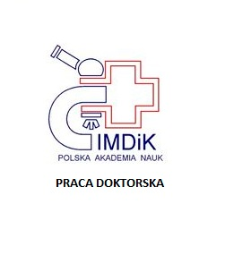
Object
Title: Analiza właściwości immunomodulacyjnych ludzkich mezenchymalnych komórek macierzystych szpiku kostnego i pochodzących z nich zewnątrzkomórkowych pęcherzyków przeszczepianych w modelu cytoksycznego uszkodzenia mózgu u szczura
Contributor:
Łukomska, Barbara (Promotor)
Publisher:
Instytut Medycyny Doswiadczalnej i Klinicznej im. M. Mossakowskiego PAN
Place of publishing:
Description:
Bibliogr. na str. 98-121 ; 121 s.: il., wykr., fotogr. ; 30 cm
Degree name:
Level of degree:
Degree discipline :
Degree grantor:
Mossakowski Medical Research Center PAS
Abstract:
The aim of the study was to compare the immunomodulatory properties of human bone marrow mesenchymal stem cells (hBM-MSCs) and extracellular vesicles derived from these cells (EVs) transplanted in focal brain ischemic rats. Verification of therapeutic effects of MSCs or proposed EVs in experimental model of brain ischemia is necessary to begin clinical trials in patients. The studies were performed in adult male Wistar rats with focal brain injury of 1μl/50nmol ouabain injected into the right hemisphere. This cytotoxic brain injury model using ouabain (the inhibitor sodium-potassium pump) has been developed in our laboratory. Two days after ischemic insult 5x105 hBM-MSCs labeled with superparamagnetic iron oxide nanoparticles conjugated with rhodamine (Molday ION) or 1x109 EVs stained with PKH26 were transplanted into the right internal carotid artery of Wistar rats and the inflow of transplanted cells in the rat brain was monitored using MRI. At day 1, 3, 7 and 14 post-transplantation rats were decapitated, the brains were removed and the presence of the donor cells was confirmed by immunohistochemical studies. The cellular immune response in the brain was evaluated by immunohistochemical stainings and the production of humoral factors was measured by Bio-Plex ProTM Cytokine, Chemokine and Growth Factor Assay (BioRad). Our results showed that hBM-MSCs or EVs infused into the rat internal carotic artery migrated into the brain of graft recipients being visible in the right injured hemisphere using MRI or confocal microscope after immunohistochemical analysis up to 7 days after transplantation. The results revealed the decrease of activated microglia and leukocytes, including CD8+ T cells, evoked by ischemia in the brain tissue, after hBM-MSCs or EVs transplantation. The infusion of hBM-MSCs or EVs leaded to the reduction of cytokines: IL-1alfa, IL-1beta, IL-6, TGF-β2 and chemokines: CXCL1, MIP-1α, MIP-3α, MCP-1 in comparison to untreated rats with ischemic brain injury
Relation:
Detailed Resource Type:
Format:
Resource Identifier:
Source:
IMDiK PAN, call no. ZS 388 ; click here to follow the link
Language:
Language of abstract:
Rights:
Creative Commons Attribution BY 4.0 license
Terms of use:
Copyright-protected material. [CC BY 4.0] May be used within the scope specified in Creative Commons Attribution BY 4.0 license, full text available at: ; -
Digitizing institution:
Mossakowski Medical Research Institute PAS
Original in:
Library of the Mossakowski Medical Research Institute PAS
Projects co-financed by:
Access:
Object collections:
- Digital Repository of Scientific Institutes > Partners' collections > Mossakowski Medical Research Institute PAS > Theses > Ph.D Dissertationes
- Digital Repository of Scientific Institutes > Literature > Thesis
Last modified:
Jan 10, 2023
In our library since:
Jan 8, 2020
Number of object content downloads / hits:
1062
All available object's versions:
https://www.rcin.org.pl/publication/89574
Show description in RDF format:
Show description in RDFa format:
Show description in OAI-PMH format:
Objects Similar
Kowalczyk, Joanna Ewa
Sarnowska, Anna
Pawlak, Elżbieta
Kapuściński, Andrzej Mossakowski, Mirosław Jan (1929–2001)
Mossakowski, Mirosław Jan (1929–2001) Gajkowska, Barbara
Kapuściński, Andrzej Mossakowski, Mirosław Jan (1929–2001)
Mossakowski, Mirosław Jan (1929–2001) Gadamski, Roman (1933–2015)
WPŁYW INDOMETACYNY NA NIEDOKRWIENNE USZKODZENIA MÓZGU U CHOMIKA MONGOLSKIEGO (MERIONES UNGUICULATUS)
Mossakowski, Mirosław Jan (1929–2001) Kwiatkowska-Patzer, Barbara

 INSTYTUT ARCHEOLOGII I ETNOLOGII POLSKIEJ AKADEMII NAUK
INSTYTUT ARCHEOLOGII I ETNOLOGII POLSKIEJ AKADEMII NAUK
 INSTYTUT BADAŃ LITERACKICH POLSKIEJ AKADEMII NAUK
INSTYTUT BADAŃ LITERACKICH POLSKIEJ AKADEMII NAUK
 INSTYTUT BADAWCZY LEŚNICTWA
INSTYTUT BADAWCZY LEŚNICTWA
 INSTYTUT BIOLOGII DOŚWIADCZALNEJ IM. MARCELEGO NENCKIEGO POLSKIEJ AKADEMII NAUK
INSTYTUT BIOLOGII DOŚWIADCZALNEJ IM. MARCELEGO NENCKIEGO POLSKIEJ AKADEMII NAUK
 INSTYTUT BIOLOGII SSAKÓW POLSKIEJ AKADEMII NAUK
INSTYTUT BIOLOGII SSAKÓW POLSKIEJ AKADEMII NAUK
 INSTYTUT CHEMII FIZYCZNEJ PAN
INSTYTUT CHEMII FIZYCZNEJ PAN
 INSTYTUT CHEMII ORGANICZNEJ PAN
INSTYTUT CHEMII ORGANICZNEJ PAN
 INSTYTUT FILOZOFII I SOCJOLOGII PAN
INSTYTUT FILOZOFII I SOCJOLOGII PAN
 INSTYTUT GEOGRAFII I PRZESTRZENNEGO ZAGOSPODAROWANIA PAN
INSTYTUT GEOGRAFII I PRZESTRZENNEGO ZAGOSPODAROWANIA PAN
 INSTYTUT HISTORII im. TADEUSZA MANTEUFFLA POLSKIEJ AKADEMII NAUK
INSTYTUT HISTORII im. TADEUSZA MANTEUFFLA POLSKIEJ AKADEMII NAUK
 INSTYTUT JĘZYKA POLSKIEGO POLSKIEJ AKADEMII NAUK
INSTYTUT JĘZYKA POLSKIEGO POLSKIEJ AKADEMII NAUK
 INSTYTUT MATEMATYCZNY PAN
INSTYTUT MATEMATYCZNY PAN
 INSTYTUT MEDYCYNY DOŚWIADCZALNEJ I KLINICZNEJ IM.MIROSŁAWA MOSSAKOWSKIEGO POLSKIEJ AKADEMII NAUK
INSTYTUT MEDYCYNY DOŚWIADCZALNEJ I KLINICZNEJ IM.MIROSŁAWA MOSSAKOWSKIEGO POLSKIEJ AKADEMII NAUK
 INSTYTUT PODSTAWOWYCH PROBLEMÓW TECHNIKI PAN
INSTYTUT PODSTAWOWYCH PROBLEMÓW TECHNIKI PAN
 INSTYTUT SLAWISTYKI PAN
INSTYTUT SLAWISTYKI PAN
 SIEĆ BADAWCZA ŁUKASIEWICZ - INSTYTUT TECHNOLOGII MATERIAŁÓW ELEKTRONICZNYCH
SIEĆ BADAWCZA ŁUKASIEWICZ - INSTYTUT TECHNOLOGII MATERIAŁÓW ELEKTRONICZNYCH
 MUZEUM I INSTYTUT ZOOLOGII POLSKIEJ AKADEMII NAUK
MUZEUM I INSTYTUT ZOOLOGII POLSKIEJ AKADEMII NAUK
 INSTYTUT BADAŃ SYSTEMOWYCH PAN
INSTYTUT BADAŃ SYSTEMOWYCH PAN
 INSTYTUT BOTANIKI IM. WŁADYSŁAWA SZAFERA POLSKIEJ AKADEMII NAUK
INSTYTUT BOTANIKI IM. WŁADYSŁAWA SZAFERA POLSKIEJ AKADEMII NAUK


































